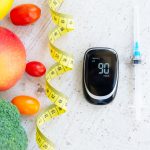Lab Work for Metabolic Syndrome
Shaida Sina, ND
It is astounding to me that nearly half of my patients have metabolic syndrome. As I thought about the disorder’s complexity, I realized that the myriad symptoms of metabolic syndrome provide an ideal example from which to discuss laboratory medicine: metabolism issues, weight gain, inflammation, hypertension … Patient generally presents with increased abdominal girth, elevated triglycerides, elevated blood sugar (not in diabetic range, however) and mild hypertension.
For the next several issues, I will walk through various scenarios of metabolic syndrome, focusing on labs.
Initial Exam Considerations
Patients complete an extensive intake form at my office. Red flags I look for on the form include: previous history of hypoglycemia, diabetes of pregnancy, weight gain, sedentary lifestyle, fatigue, allergies, thyroid symptoms, history of high blood pressure, history of kidney stones or gout, skin tags, adult acne, history of infertility, excessive stress, menstruation issues, alcohol intake, smoking and family history of hypertension, diabetes, PCOS.
A patient’s first visit with me generally lasts 1-1/2 to 2 hours. I do not always perform a thorough physical exam on the first visit, but I always check vital signs, heart and lungs. If I am the primary care physician, I also set up goal lists with the patient, which may include: gyn exam, follow-up lab review, thermal imaging, bone density and so forth.
Blood Work Considerations
Many factors can affect blood work, such as exercise or lack thereof, alcohol, supplements and medication. Generally, I do not restrict diet or exercise prior to blood work being drawn, because I am looking for a snapshot of what is going on in the body. Labs should be used to support clinical finding and history.
My instructions to patients who will be having blood drawn include: “No food after 9 p.m., water is OK.” Drinking a normal amount of water is important, because dehydration can 1) impede blood flow during the draw, and 2) affect lab results. I tell patients not to take medications the morning of their blood draw, unless I am monitoring peak levels of drugs.
At lab review, I will ask patients if they drank water, ate anything or took any medications prior to their blood draw. I also explain to men that the following activities may falsely elevate the PSA enzyme: vigorous sex, horseback riding, intense mountain biking and (in my neck of the woods) bull riding.
Criteria for Metabolic Syndrome
Conventional diagnosis of metabolic syndrome is based on the following criteria:
- Fasting blood glucose: >110 mg/dl (some sources say 115)
- Blood pressure: >135/85
- Waistline: >35 inches
- Fasting triglycerides: >150mg/dl
- Elevated uric acid: >6mg/dl.
As naturopathic physicians, we should take a more critical look at these standards for diagnosis. I believe that the skills of laboratory medicine help diagnose metabolic syndrome in its early stages. My criteria for diagnosing metabolic syndrome are as follows:
Blood Sugar: Fasting glucose should be less than 90mg/dl (optimum is 70-85mg/dl). About 80% of my patients whose blood sugar is greater than 90 test positive for insulin resistance. When glucose dips below 70, hypoglycemia becomes a concern. In my practice, I found that reactive hypoglycemia left untreated develops into insulin resistance.
Fats: My optimum range for cholesterol falls around 180-200mg/dl. Borderline high cholesterol is 201-240mg/dl, and high cholesterol is >240; all of this is relative to the type of fat differentiated. Triglycerides should be <100mg/dl; consider 100-150 as borderline. In general, HDL should be at least >50mg/dl; LDL <100mg/dl. Suspicious values of LDL are 101-130. Very low-density lipid (VLDL) should be <20. From these values I do additional calculations: Total cholesterol:HDL ratio should be 2:3 (for women) or 3:4 (for men); LDL:HDL ratio should be <2; TG:HDL ratio should be <2.
Uric Acid: Uric acid is an indicator of gout, but it can also be elevated in the following conditions: atherosclerosis, oxidative stress, rheumatoid arthritis, kidney disease, alcoholism, some neoplasms, liver disease and lead poisoning. Optimum uric acid is 2-5mg/dl.
Case Study: Initial Labs
Mrs. M, a 63-year-old Caucasian female, presented to my office with fatigue, weight gain, abnormal endometrial growth, mild depression, alcohol abuse, arthritis and chronic UTIs. Her original goal was to avoid a hysterectomy. Significant initial exam findings: BP, 160/90; pulse, 65; temp, 96.5; abdominal girth, >35 inches; height, 5’6’’; weight, 168. She had no previous history of hypertension. She was under a lot of stress, having just put her husband into a nursing home due to Alzheimers.
Mrs. M’s clinically significant labs: Recent hx of thyroid deficiency (THS was normal, but T4 was low); she was put on L-thyroxine 25mcg/day. Her THS was 2.0 and Free T4 was OK, but Free T3 was low (I will review thyroid in another column). Her fasting glucose was 94 – optimum is <90 – which indicates some degree of insulin resistance. Protein is slightly low, which most likely indicates HCL deficiency, which may lead or has led to nutritional deficiencies. Her white blood cell count was clinically low, indicating chronic infection (dental and candida). Cholesterol was 230, LDL 142; Triglycerides 135; uric acid 5.2.
Lab Test Lingo
Lab jargon can be confusing, as different laboratories might call their panels by different names. For example, SMAC may be equivalent to CMET. A general screen I perform for most patients includes:
- BMET: Sodium, Potassium, Chloride, Carbon Dioxide
- Liver profile: AST, ALT, Alk phos, GGT, LDH, Biliruben
- Kidney profile: BUN, Creatinine, Uric Acid
- Lipid profile: Cholesterol, Triglycerides, HDL, LDL, VLDL
- Complete Blood Count Profile: RBC, WBC, H&H, MCH, MCHC, MCV, PLT, /c differential (Seg, lymph, mono, eos, baso)
- Nutrient panel: Calcium, phosphorus, ferritin, foliate, B12
- THS, urinalysis if symptoms present
- For men older than 40, I request a PSA annually. Consider doing a baseline at 35 years or if there is a family history of prostate disease. Do not perform a digital exam prior to PSA testing, because it will falsely increase the value.
- Optional test: A1C and/or fasting insulin.
Along with lab jargon, lab costs differ, as well. I negotiate special pricing with local labs to accommodate patients whose health insurance does not cover labs. Labs will develop personalized panels for your convenience and offer competitive pricing.
I did not yet diagnose Mrs. M with metabolic syndrome. To do so, I will order several more tests, which I will discuss next issue.
 Shaida Sina, ND, has been working in the field of medicine for more than 20 years. She received her BS from the University of Maryland, in the School of Medicine’s Department of Medical and Research Technology. During her first 10 years in health care, she worked in the field of laboratory medicine where she ultimately became lead technologist of a reference infectious disease laboratory. Sina began her studies in natural medicine in 1995 at SCNM and was the first naturopathic physician to do a clinical rotation at Mayo Clinic, where she trained in reproductive endocrinology. Her areas of clinical focus include women’s health care, pediatrics and general family practice.
Shaida Sina, ND, has been working in the field of medicine for more than 20 years. She received her BS from the University of Maryland, in the School of Medicine’s Department of Medical and Research Technology. During her first 10 years in health care, she worked in the field of laboratory medicine where she ultimately became lead technologist of a reference infectious disease laboratory. Sina began her studies in natural medicine in 1995 at SCNM and was the first naturopathic physician to do a clinical rotation at Mayo Clinic, where she trained in reproductive endocrinology. Her areas of clinical focus include women’s health care, pediatrics and general family practice.










